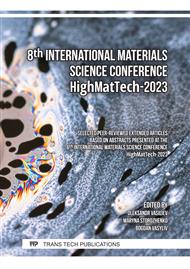[1]
L.J. Gibson, M. F. Ashby, Cellular Solids: Structure and Properties, Cambridge: Cambridge University Press, 1997.
Google Scholar
[2]
M. F. Ashby, A. G. Evans, N. A. Fleck et al., Metal Foams: A Design Guide, Butterworth Heinemann, Boston, USA, 2000.
Google Scholar
[3]
J. Banhart, Manufacture, characterisation and application of cellular metals and metal foams, Progress in Materials Science, 46 (6) (2001) 559-632. doi.org/
DOI: 10.1016/S0079-6425(00)00002-5
Google Scholar
[4]
V. Crupi, G. Epasto, E. Guglielmino, Impact response of aluminum foam sandwiches for light-weight ship structures, Metals, 1 (1) (2011) 98-112. doi.org/
DOI: 10.3390/met1010098
Google Scholar
[5]
G. Palomba, G. Epasto, V. Crupi, Lightweight sandwich structures for marine applications: a review, Mechanics of Advanced Materials and Structures, 06.07.2021
DOI: 10.3233/PMST200051
Google Scholar
[6]
T. J. Lu, A. Hess, M. F Ashby, Sound absorption in metallic foams, Journal of Applied Physics, 85 (1999) 7528-7539.
DOI: 10.1063/1.370550
Google Scholar
[7]
A. Byakova, S. Gnyloskurenko, Y. Bezimyanniy, T. Nakamura, Closed-cell aluminum foam of improved sound absorption ability: manufacture and properties, Metals, 4 (3) (2014) 445-454. doi.org/
DOI: 10.3390/met4030445
Google Scholar
[8]
Gama, B. A.; Bogetti, T. A.; Fink, B. K.; Yu, Chin-Jye; Claar, T. Dennis; Eifert, Harald H. Aluminum foam integral armor: a new dimension of armor design, Composite Structure, 52 (3 -4), (2001) 381–395. doi.org/
DOI: 10.1016/S0263-8223(01)00029-0
Google Scholar
[9]
Schaeffler P, Berthold P. Alulight international Gmbh Ranshofen, Austria: processing and properties of Alulight® aluminum foams and sandwich panels for shipboard applications. National Shipbuilding Research Program Panel on Product Development and Materials Technology Biloxi, MS; 14 February 2008.
Google Scholar
[10]
Z. Xu, H. Hao, Electromagnetic interference shielding effectiveness of aluminum foams with different porosity, Journal of Alloys and compounds, 617 (2014) 207-213. doi.org/
DOI: 10.1016/j.jallcom.2014.07.188
Google Scholar
[11]
X. Zhu, S. Ai, X. Lu, X. Ling, L. Zhu, B. Liu, Thermal conductivity of closed-cell aluminum foam based on the 3D geometrical reconstruction, International Journal of Heat and Mass Transfer, 72 (2014) 242-249. doi.org/
DOI: 10.1016/j.ijheatmasstransfer.2014.01.006
Google Scholar
[12]
J. Banhart, H.-W. Seeliger, Aluminium foam sandwich panels: manufacture, metallurgy and applications, Advanced Engineering Materials, 10 (9) (2008) 793-802. doi.org/
DOI: 10.1002/adem.200800091
Google Scholar
[13]
B. A. Gama, T. A. Bogetti, B. K. Fink et al., Aluminum foam integral armor: a new dimension of armor design, Composite Structures, 52 (3-4) (2001) 381–395. doi.org/
DOI: 10.1016/S0263-8223(01)00029-0
Google Scholar
[14]
P. Schaeffler, W. Rajner, D. Claar, T. Trendelenburg, H. Nishimura, Production, properties, and applications of Alulight® closed-cell aluminum foams, in Proceedings of the Fifth International Workshop on Advanced Manufacturing Technologies, London, Canada, May 2005.
Google Scholar
[15]
J. Banhart, Light-metal foams-history of innovation and technological challenges, Advanced Engineering Materials, 15 (3) (2013) 82–111. doi.org/
DOI: 10.1002/adem.201200217
Google Scholar
[16]
S. Akiyama, H. Ueno, K. Imagawa, A. Kitahara, S. Nagata, K. Morimoto, T. Nishikawa, M. Itoh, Foamed metal and method of producing same, European Patent 0 210 803, 1989 (1986).
Google Scholar
[17]
S. Akiyama, H. Ueno, K. Imagawa, A. Kitahara, S. Nagata, K. Morimoto, T. Nishikawa, M. Itoh, Foamed metal and method of producing same, US Patent № 4713277, 1987.
Google Scholar
[18]
S.V. Gnyloskurenko, T. Nakamura, A.V. Byakova Y.M. Podrezov, R. Ishikawa, M. Maeda. Development of lightweight Al alloy and technique, Canadian Metallurgical Quarterly, Vol.44 1 (2005) 7-12. doi.org/
DOI: 10.1179/cmq.2005.44.1.7
Google Scholar
[19]
A. Byakova, A. Sirko, K. Mykhalenkov, Yu. Milman, S. Gnyloskurenko, T. Nakamura, Improvements in Stabilisation and Cellular Structure of Al based Foams with Novel Carbonate Foaming Agent, High Temperature Materials and Processes, Vol. 26 No. 4 (2007) 239-246. doi.org/
DOI: 10.1515/HTMP.2007.26.4.239
Google Scholar
[20]
Koizumi T., Kido K., Kita K., Mikado K., Gnyloskurenko S., Nakamura T., Method of Preventing Shrinkage of Aluminum Foam Using Carbonates, Metals 2 (2011) 1-9
DOI: 10.3390/met2010001
Google Scholar
[21]
V. Byakova, A. A. Vlasov, S. V. Gnyloskurenko, I. Kartuzov, Method for making the blocks of foamed aluminum/aluminum alloys, UA Patent no. 104367 (2014).
Google Scholar
[22]
L. J. Gibson, Mechanical behavior of metallic foams, Annual Review in Material Science, 30 (1) (2000) 191-227. doi.org/
DOI: 10.1146/annurev.matsci.30.1.191
Google Scholar
[23]
B. Kriszt, B. Foroughi, K. Faure, H. P. Degischer, Behaviour of aluminium foam under uniaxial compression, Materials Science and Technology, 16 (7-8) (2000) 792-796. doi.org/
DOI: 10.1179/026708300101508450
Google Scholar
[24]
A.E. Markaki, T.W. Clyne, The effect of cell wall microstructure on the deformation and fracture of aluminum-based foams, Acta Materialia, 49 (2001) 1677-1686. doi.org/
DOI: 10.1016/S1359-6454(01)00072-6
Google Scholar



